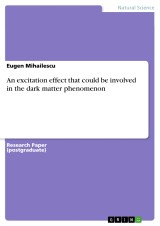Details

An excitation effect that could be involved in the dark matter phenomenon
1. Auflage
|
36,99 € |
|
| Verlag: | Grin Verlag |
| Format: | |
| Veröffentl.: | 22.02.2005 |
| ISBN/EAN: | 9783638351973 |
| Sprache: | englisch |
| Anzahl Seiten: | 124 |
Dieses eBook erhalten Sie ohne Kopierschutz.
Beschreibungen
Research Paper (postgraduate) from the year 2005 in the subject Physics - Astronomy, , language: English, abstract: The dark matter phenomenon is known since 1933 and it correlates with the
formation and the stability of galaxies and other large-scale structures. In the year 1933 Fritz
Zwicky discovered a stabilization effect connected to the Coma cluster of galaxies [Zwicky,
F. Helv. Phys. Acta 6, 110 – 127 (1933)]. The first interpretation of this stabilization effect
leaded to the hypothesis of dark matter particles that could correlate with a gravitational effect
and that could be involved in the stability of galaxies. Despite the fact that the stability of
galaxies and galaxy clusters is known since more then 70 years, no consistent experimental
data is presently known to support the hypothesis of dark matter particles. The assumed dark
matter particles are presently not yet detected. The main experiment regarding dark matter
particles of the year 2004, respectively the CDMS II experiment [D.S. Akerib et al., Phys.
Rev. Lett. 93, 211301 (2004)] could not confirm the existence of dark matter particles,
respectively of WIMPs (weakly interacting massive particles).
Following an alternative interpretation of the stabilization effect performed by galaxies and
other large-scale structures connected to a boson field, a special excitation effect was found.
This special excitation effect occurs without any presently known form of excitation and it is
detectable in connection with different kind of material samples inside the cavity of a black
body during laboratory experiments as well as during experiments performed outdoors in free
nature. This excitation effect is followed by a regular pattern of emission in the spectral range
of 160 – 630 nm at 273 – 300 K. The regular pattern of emission is uninterrupted detectable
for at least 7 days in connection with samples made of granite and granodiorite.
formation and the stability of galaxies and other large-scale structures. In the year 1933 Fritz
Zwicky discovered a stabilization effect connected to the Coma cluster of galaxies [Zwicky,
F. Helv. Phys. Acta 6, 110 – 127 (1933)]. The first interpretation of this stabilization effect
leaded to the hypothesis of dark matter particles that could correlate with a gravitational effect
and that could be involved in the stability of galaxies. Despite the fact that the stability of
galaxies and galaxy clusters is known since more then 70 years, no consistent experimental
data is presently known to support the hypothesis of dark matter particles. The assumed dark
matter particles are presently not yet detected. The main experiment regarding dark matter
particles of the year 2004, respectively the CDMS II experiment [D.S. Akerib et al., Phys.
Rev. Lett. 93, 211301 (2004)] could not confirm the existence of dark matter particles,
respectively of WIMPs (weakly interacting massive particles).
Following an alternative interpretation of the stabilization effect performed by galaxies and
other large-scale structures connected to a boson field, a special excitation effect was found.
This special excitation effect occurs without any presently known form of excitation and it is
detectable in connection with different kind of material samples inside the cavity of a black
body during laboratory experiments as well as during experiments performed outdoors in free
nature. This excitation effect is followed by a regular pattern of emission in the spectral range
of 160 – 630 nm at 273 – 300 K. The regular pattern of emission is uninterrupted detectable
for at least 7 days in connection with samples made of granite and granodiorite.

















